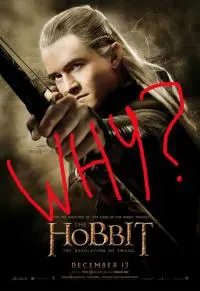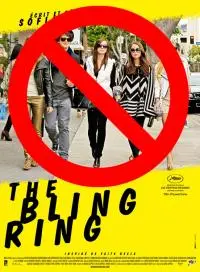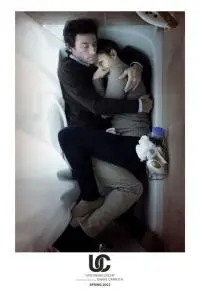This column was born out of a desire to inject a little film criticism into my work here at LitReactor. Spice things up a bit. After all, screenwriters and film directors are storytellers too, and we can learn just as much about narrative from watching movies as we can by reading books. So I pitched an article on the best screenwriting of 2013.
Of course, that was before I wrote about my favorite films of the year for Twitch. My LitReactor article would have been essentially the same list. Which made me realize, when critics talk about screenplays, they generally aren't talking about the physical, typed document. The actual "writing." Do you think members of the Academy read all those scripts before casting their Oscar ballots? No, they're going off the finished product. And to me, there is a definite difference between a film on the page and a film on the screen. So since I didn't want to misrepresent like that—and wasn't about to go on a massive script reading bender—I had to improvise. Thus: Five simple lessons I learned about storytelling from watching films in 2013.
Size Matters
And not in the way you think. Bigger isn't necessarily better. As David Lynch once said about Inland Empire, a film needs to be the length "that feels right." Of course, what "feels right" is completely subjective, and Lynch was dead wrong about his self-indulgent, 180 minute thriller.
 There was a lot of bloat at the box office this year. Peter Jackson's The Hobbit: The Desolation of Smaug and Martin Scorsese's Wolf of Wall Street were two of the main offenders, and together they led the assault on asses. Both films are adaptations of books, and you might think, therein lies the problem, but no. The problem with The Hobbit isn't the length of the source material (the book is only 310 pages long). The problem is Jackson and his co-writers added so much extra, the adaptation ballooned to the size of three films. And as exciting as the Hobbit films are, there have been complaints across the board about their narrative excess.
There was a lot of bloat at the box office this year. Peter Jackson's The Hobbit: The Desolation of Smaug and Martin Scorsese's Wolf of Wall Street were two of the main offenders, and together they led the assault on asses. Both films are adaptations of books, and you might think, therein lies the problem, but no. The problem with The Hobbit isn't the length of the source material (the book is only 310 pages long). The problem is Jackson and his co-writers added so much extra, the adaptation ballooned to the size of three films. And as exciting as the Hobbit films are, there have been complaints across the board about their narrative excess.
Speaking of excess, the makers of Wolf of Wall Street have taken a page from the playbook of their film's subject, corrupt stockbroker Jordan Belfort. The three hour film goes to excess in portraying his excess, and suffers for it. The myriad scenes of debauchery are not only repetitive, they are overlong. And it could have been worse. In a recent behind the scenes featurette, editor Thelma Schoonmaker discussed how the film originally clocked in at four hours. Not only that, but "trimming an hour wasn’t a matter of losing whole scenes, but trimming things across the board." Seems to me, they didn't trim enough. The existing film could easily have lost another 30 minutes of flab. You've heard the expression Kill your darlings? Well, as great as Wolf of Wall Street is, it's got way too many darlings. As a storyteller, you can't be self-indulgent and let your scenes run on. You need to get in, make your point, and get out.
Characters Can Be Unlikable, But They Have To Be Interesting
Some viewers/readers have problems relating to unlikable characters, but for me, it's more important they be interesting. You could be telling the story of the biggest scumbag on earth, but if he/she is engaging, I'm right there with you. There were a number of films this year that featured this type of character, protagonists that ran the gamut from "selfish dick" to "full-on sociopath." Not all of them were good, but a handful of them were great.
A perfect example is Inside Llewyn Davis, written and directed by Joel and Ethan Coen. If anyone knows how to write a great unlikable character, it's the Coen brothers. Llewyn Davis, played to perfection by Oscar Isaac, is a self-centered jerk, but he's a fascinating one, and not without his charm. Not only that, he isn't even the biggest jerk in the film, which makes him almost likable by default. It also doesn't hurt that the Coens send him on one of their patented odysseys full of bizarre characters and situations.
 Slightly higher on the jerk scale is Cate Blanchet's Jasmine in Blue Jasmine. God, she's insufferable, but you can't take your eyes off her. Part of this is due to the performance, but part of it is Woody Allen's ability to evoke the audience's sympathy. We shouldn't care what happens to her, but we do. Even though she deserves what she gets, we can't help but feeling a little bit sorry for her.
Slightly higher on the jerk scale is Cate Blanchet's Jasmine in Blue Jasmine. God, she's insufferable, but you can't take your eyes off her. Part of this is due to the performance, but part of it is Woody Allen's ability to evoke the audience's sympathy. We shouldn't care what happens to her, but we do. Even though she deserves what she gets, we can't help but feeling a little bit sorry for her.
But what if a character's actions are so abhorrent, their unlikability is off the charts? Take Lester Ballard in James Franco's adaptation of Cormac McCarthy's Child of God. How unlikable is he? He's an unrepentant necrophiliac and serial killer. And he's not even charming like Patrick Batemen. He wallows in filth and barely speaks in coherent sentences. But he's such an anomaly, you are compelled to keep watching. Again, this is aided by an amazing performance, by relative newcomer Scott Haze, but even in McCarthy's novel, there is a sympathy to be had for Ballard.
But not every film can pull this off. Two of the years biggest offenders were Sofia Coppola's lifeless The Bling Ring, and Paul Schrader's The Canyons, written by none other than Bret Easton Ellis. Ellis knows a thing or thirteen about horrible people we love to read about, but just plain phones it in with this script. Maybe something was lost in the translation, but every character in this film is turgid and uncompelling. The same goes for The Bling Ring. Coppola's superficial characters are rendered uninteresting because they lack any sort of dimension. I wanted to stab them in the face, and then gouge out my own eyes. It just goes to show, sometimes talented people get it wrong.
And Wolf of Wall Street is another conversation altogether, one that has to do with the perceived glorification of unlikable people by the filmmakers. One thing you never want to do is condone the horrible actions of your horrible characters.
If You're Doing Something That's Been Done Before, Do It Well
If you're working in a well-trod genre, and you're going to do something that's been done a million times, you'd better do it well. Otherwise, don't even bother. One of this year's best-reviewed horror films was James Wan's The Conjuring. It's your typical haunted house/demonic possession story—by no means an original idea. But the characters are well-drawn, the narrative is solid, and it is fraught with tension. What more do you want from a horror flick? Same thing goes for We Are What We Are. Granted, the "hillbilly cannibal" genre isn't quite as popular, but trust me—it's been done. What makes WAWWA stand out (WAWWA!) is that it takes the premise seriously and tells a solid, character driven story. You don't necessarily need to re-invent the wheel (although that's nice, too). Just show a modicum of competence. A little goes a long way, especially in genres that are looked upon as inferior.
Another genre that's treated like a bastard step-child is the romantic comedy. But then along comes a film like Spike Jonze's Her and breathes new life into it. Sure, it has an original narrative hook—that of a man falling in love with an operating system—but at its heart, it's the same boy-meets-girl romance audiences have been eating up for years. And it's a well-written one, to boot, with shimmery dialogue that isn't emotionally manipulating. It's also legitimately funny. Take away the tech angle and it would still be better than your average rom-com. And average is bad. Don't be average. Whatever story you choose to tell, tell it well.
How You Tell A Story Is Just As Important As The Story Itself
 On paper, a movie like Spring Breakers couldn't sound less interesting. A trio of broke college girls turns to robbery so they can afford to go on Spring Break. BO-RING. But tell that story as a hyper-realistic fantasy, full of dream-like scenes that overlap one another, and you've got something special. Despite the lurid subject matter, director Harmony Korine exhibits a maturity in his approach, handling the material with complete assurance. A similar style also worked wonders in Shane Carruth's Upstream Color, and served to turn a simple story into a complex emotional journey. In both films, the filmmaking influences the tone of the narrative and reflects the characters' state of mind.
On paper, a movie like Spring Breakers couldn't sound less interesting. A trio of broke college girls turns to robbery so they can afford to go on Spring Break. BO-RING. But tell that story as a hyper-realistic fantasy, full of dream-like scenes that overlap one another, and you've got something special. Despite the lurid subject matter, director Harmony Korine exhibits a maturity in his approach, handling the material with complete assurance. A similar style also worked wonders in Shane Carruth's Upstream Color, and served to turn a simple story into a complex emotional journey. In both films, the filmmaking influences the tone of the narrative and reflects the characters' state of mind.
Of course, this approach isn't always successful. Although he's created masterpieces with similar methods, turning minimal story into impressionistic art didn't work so well for Terence Malick's latest, To The Wonder. No matter how you dress up a story, if it doesn't connect with the audience you are dead in the water. There has to be a balance. But if you'd rather blame Wonder's failure on Ben Affleck, be my guest.
Not everything has to be artsy-fartsy, however. Take a film like Alfonso Cuaron's Gravity. It's a pretty straight-forward story of survival, which almost qualifies it for "If You're Doing Something That's Been Done Before, Do It Well." But this film is bigger than just its premise. There is a level of technical sophistication that elevates this film to the status of an event. The visual aesthetic is almost its own language, and that language does the bulk of the storytelling. I know film is a more visual medium, but that doesn't mean you can't learn an abstract lesson from this example. If you could figure out the literary equivalent to the spectacle of Gravity, you'd have an instant classic on your hands.
Don't Underestimate Your Audience
If you water down your vision in an attempt to broaden your appeal, you may just wind up alienating the audience that matters. Take The Grandmaster. The film tells the story of martial arts expert Ip Man, who trained Bruce Lee, amongst many others. Multiple popular action movies based on his life have already been made, so how hard could it be to sell audiences on another one? Especially one directed by an auteur like Wong Kar-wai? Oh, I forgot. He's one of them arty directors. We'd better re-edit the film to make it easier to understand for those dumb 'Mericans. ("We" being Harvey Weinstein. Shocker.) Make the structure more linear, spoon-feed them the historical context. Well, guess what? The people who are going to appreciate a Wong Kar-wai film are not going to appreciate a "Dummies" version, and no matter how much you water it down, neither are the people who want straight-up action. It's a lose-lose.
The Grandmaster isn't the only film Weinstein is dumbing down. Bong Joon-ho's Snowpiercer is a study in class structure that takes place in a post ice age society on a train. (I'm cheating a bit here because the film has yet to be released in the US.) The lower class citizens, who live at the back of the train, stage a revolt, fighting one car at a time towards the engine. Sounds awesome, right? Nope. We are too stoopid. Despite English dialogue, an international cast, and glowing reviews, Harvey Scissorhands wants to cut important character detail to make the film more accessible to middle-America. Important character detail. It boggles the mind. I can't believe this even needs to be said, but don't treat your audience like idiots. In fact, that might be the most important lesson of all.
What about you, LitReactors? I know many of you are movie buffs. What were some of your favorite films this year? Least favorite? And what lessons about storytelling did they impart?
Here's to another year of great films and great storytelling.

About the author
Joshua Chaplinsky is the Managing Editor of LitReactor. He is the author of The Paradox Twins (CLASH Books), the story collection Whispers in the Ear of A Dreaming Ape, and the parody Kanye West—Reanimator. His short fiction has been published by Vice, Vol. 1 Brooklyn, Thuglit, Severed Press, Perpetual Motion Machine Publishing, Broken River Books, and more. Follow him on Twitter and Instagram at @jaceycockrobin. More info at joshuachaplinsky.com and unravelingtheparadox.com.







